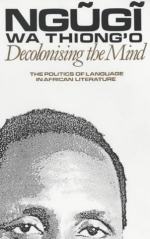
|
| Name: _________________________ | Period: ___________________ |
This quiz consists of 5 multiple choice and 5 short answer questions through Chapter 1 (Parts IV-V): "The Language of African Literature" .
Multiple Choice Questions
1. The author states in Chapter 1, Part IV, "Language as culture is the collective memory bank of a people's" what (15)?
(a) "Experience in history."
(b) "Suffering and domination."
(c) "Perceptions of outsiders."
(d) "Family and bloodline."
2. According to the author in Chapter 1, Part I, as an effect of colonization, Africa was defined in the languages of Europe. What three languages does he describe?
(a) French, Spanish, and German.
(b) Dutch, French, and Portuguese.
(c) English, French, and Spanish.
(d) English, French, and Portuguese.
3. Since when does the author state imperialism has affected the lives of even the peasants in the remotest corners of our countries in his Introduction?
(a) 1896.
(b) 1884.
(c) 1859.
(d) 1865.
4. Who wrote Contes d'Amadou Koumba?
(a) Martin Carter.
(b) Birago Diop.
(c) Gabriel Okara.
(d) Amos Tutuola.
5. In Chapter 1, Part I, the author asserts, "The choice of language and the use to which language is put is central to" what (4)?
(a) "A people's relationship to others."
(b) "A people's disenfranchisement."
(c) "A people's notions about literature."
(d) "A people's definition of themselves."
Short Answer Questions
1. When did the author submit The River Between to a writing competition by the East African Literature Bureau?
2. What novel of the author's did he hope to give a transcript of to Chinua Achebe at the writers' conference described in Chapter 1, Part II?
3. What term used by the author in the Introduction is defined by him as having the effect of annihilating a people's belief in their names, languages, unity, and ultimately, themselves?
4. What were largely featured as the main characters in the stories that Ngũgĩ wa Thiong’o grew up listening to as a child?
5. When was Things Fall Apart published?
|
This section contains 281 words (approx. 1 page at 300 words per page) |

|




